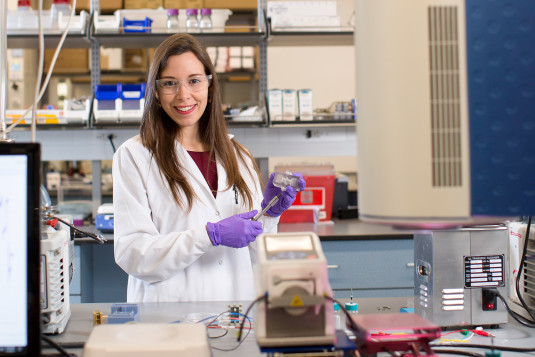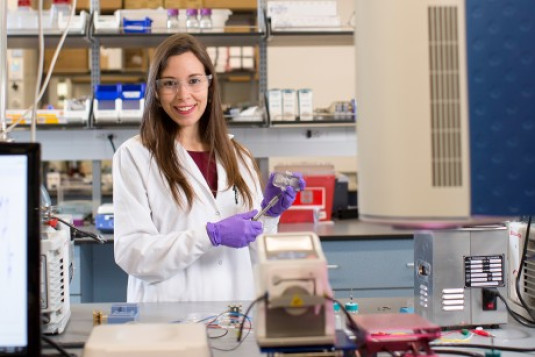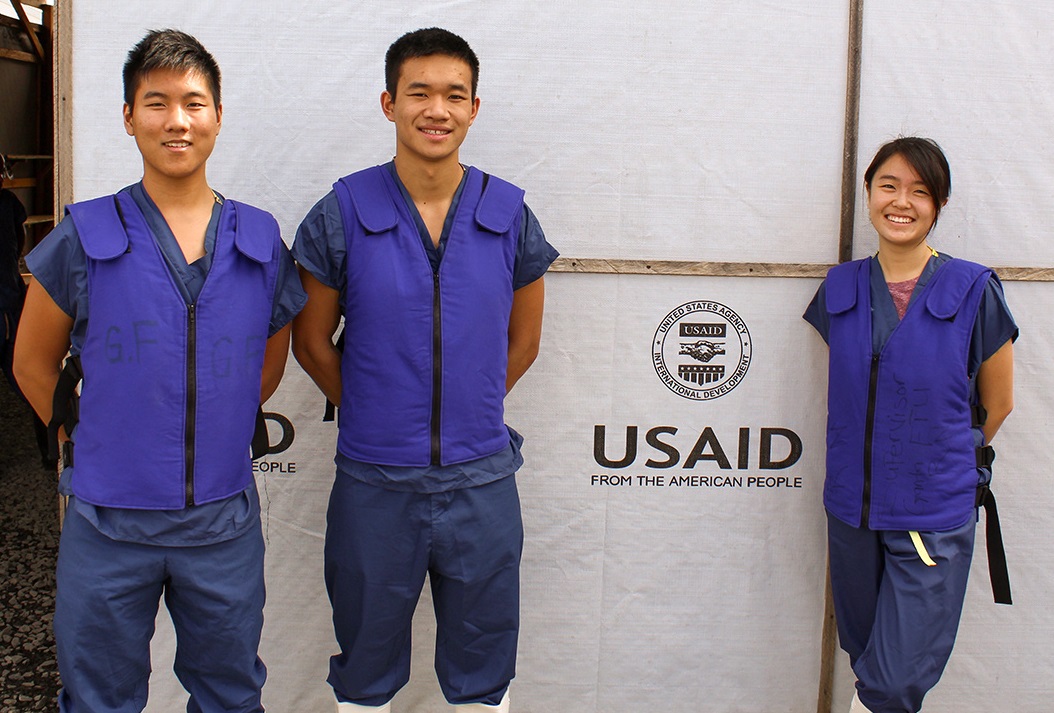
Innovating to fight Ebola
Motivated by Columbia University's 2014 Design Challenge to fight Ebola, Jason Kang, Katherine Jin, and Kevin Tyan created Highlight, an additive that temporarily colors disinfectants made with bleach so users can confirm they've properly treated a contaminated surface. The trio founded Kinnos to develop and market their product, and they're now firmly establishing themselves in the world of infection prevention. Looking back on their success so far, Kang, Jin, and Tyan credit healthcare workers for important lessons learned, not only about their product, but also about what it really means to make a difference.
20 min read
Each month, our Journeys of Innovation series tells the stories of inventors or entrepreneurs who have made a positive difference in the world. Hear it in their own words or read the transcript below.
Katherine Jin: By meeting the people that were actually on the ground, saving lives, frontline workers that were trying to protect patients, it also contextualized the work that we did. It made us realize how crucially important infection prevention is.
Marie Ladino: Learning directly from healthcare workers in West Africa was a crucial step in the efforts of Jason Kang, Katherine Jin, and Kevin Tyan to develop Highlight, a life-saving additive for disinfectants initially created to help fight Ebola. When mixed with bleach, Highlight turns the disinfectant blue, making it easy for users to see which surfaces they've treated. The color fades away once the bleach has done its job. Now, as the world navigates the COVID-19 pandemic, Kinnos, the team's company, is focused on developing a strong presence in the field of infection prevention.
I'm Marie Ladino from the United States Patent and Trademark Office. I recently spoke to the Kinnos co-founders about their experiences as young inventors and entrepreneurs. You'll hear from Kang first, followed by Tyan and Jin.
We view patents as a way to justify the investment of time and resources and energy into creating these new innovations, not necessarily just because it's important for the business to be able to be the one that commercializes it, but also because if we don't, someone else might.
Marie Ladino: So let's start at the beginning. How did the three of you first meet?
Jason Kang: We met pretty early on in freshman year of college. We all went to Columbia University together. Katherine and I met probably like first week of classes, and Kevin and I actually pledged in the same fraternity together, and that's where we met. I was studying biomedical engineering, Katherine computer science and biology, and we just ended up having a lot of the same classes together. So over time, we just formed a very natural friendship. We all come from a similar sort of background and clicked really well together.
Marie Ladino: So can you tell me about your product Highlight and how it came about? What led you to develop it?
Kevin Tyan: In our junior year, while we were classmates at Columbia, was when the Ebola crisis erupted and was all over the news. And so Columbia wanted to do something about it. They hosted the Columbia Ebola Design Challenge, inviting students and faculty to come up with solutions to help out with the crisis. This wasn't something that we were all very familiar with, but Katherine convinced Jason to just bite the bullet and go to the first presentation. And there, we learned from workers who had actually come from being on the ground in West Africa that ineffective disinfection was something that was directly harming them.
The inability to disinfect themselves after treating Ebola patients was directly causing infections. And the big reason was because they couldn't properly see where they were spraying bleach. And so we banded together and decided, “How do we improve that problem?” And so from there, we came up with the idea of Highlight, and the first idea was actually to create PPE [personal protective equipment] suits that would change color when you spray bleach on it, showing that you had disinfected the entire suit. But then we actually switched to “Why don't we put the color directly into the bleach so that once you spray it onto the suit, you can see exactly where you spray it, and make sure you've covered every spot, every equipment, every crevice, and keep these workers safe?”

In June 2016, healthcare workers in Conakry, Guinea, performed decontamination procedures with a chlorine solution alone (left) and a Highlight-enhanced chlorine solution (right) as part of the training the Kinnos team conducted in West Africa.
Marie Ladino: And you actually went to West Africa and met some of the healthcare workers there. What was that experience like?
Katherine Jin: During the Ebola epidemic, with our Highlight product, was definitely one of the most significant experiences in our life. Until then, I think we had really been focused a lot on school and kind of the classic path forward, maybe going to grad school and getting a job, but going to Liberia and actually getting to work with healthcare workers, people who are being impacted on the ground there, was really an eye-opening and world-opening experience for us, in understanding how much of a bubble we lived in, in understanding the issues people face around the world, and also understanding what we as students, and at the time innovators—I guess still now innovators—are capable of.
I think until we went to West Africa, we had always assumed that we were just too young and too uneducated to be able to do anything that had an actual impact on people's lives, but this whole process, especially being able to implement it, really taught us that if you put your mind to something, you can learn anything you want, and you can really make an impact if you have the desire to do so. What also was really great about the process is by meeting the people that were actually on the ground, saving lives, frontline workers that were trying to protect patients, it also contextualized the work that we did. It made us realize how crucially important infection prevention is and how we're largely failing our healthcare workers, not only in epidemic settings, like Ebola in Liberia, but even now, in hospitals all around the world. And this is especially topical with the COVID-19 epidemic.
Marie Ladino: With the outbreak of COVID-19, what was the past year like for Kinnos?
Jason Kang: With everyone in the world, it was a very hectic, challenging, difficult year. I think one of the interesting things that we've learned not just from the Ebola outbreak, but also the COVID-19 pandemic, is that it's quite difficult to get people to use completely new innovations in the middle of the outbreak. People tend to turn to things that they're very comfortable and familiar with.
All of that being said, it's also been certainly an exciting year in the sense that infection prevention has never really been on the forefront of people's minds. In the health tech space, med tech space, you always think typically first of diagnostics, vaccines, medical devices, drugs, things where if you give it to a person, there's almost an immediate, tangible outcome. Prevention is traditionally a much harder metric to keep track of. If you do your job correctly, there is no, there's no effect, right? And for the first time ever, things like bleach and disinfection are sexy topics that people really care about. And so being able to be here now with our Highlight technology and being able to quantifiably improve disinfection techniques makes people feel more confident that surfaces are being disinfected properly. I think that that's been really exciting for us.
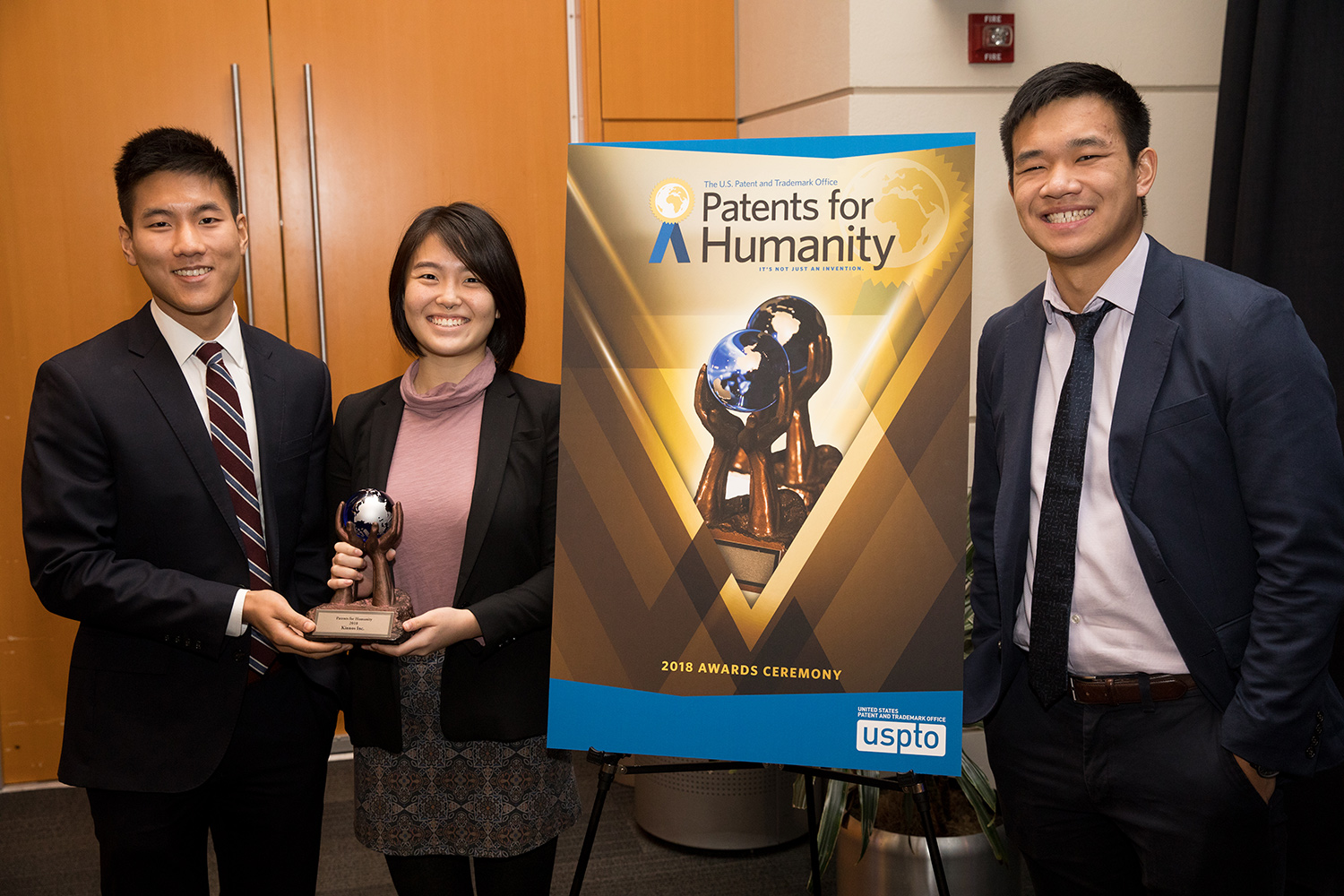
In November 2018, the Kinnos co-founders received a Patents for Humanity Award for their invention of Highlight. The USPTO's Patents for Humanity Program recognizes innovators who use game-changing technology to meet global humanitarian challenges. (Photo by Jay Premack/USPTO)
Marie Ladino: The three of you have received numerous awards for your invention of Highlight. You've been selected as finalists in the National Inventors Hall of Fame's Collegiate Inventors Competition and won the USAID Fighting Ebola Grand Challenge, and Kinnos received a Patents for Humanity Award, among many other accolades. How did these experiences impact your trajectory as inventors and entrepreneurs?
Jason Kang: I think that one of the kind of nice parts of starting a company when you're a student is that there's actually a lot of student-friendly competitions out there that give you exposure and funding, and the ability to meet a lot of really awesome, interesting people. I think one of the biggest challenges of starting a company, particularly in the healthcare space, being so young, is that having credibility and having experience matters a lot when health and lives are on the line. You know, how do you get yourself and your innovation over to an Ebola treatment center? How do you convince the director of an emergency health NGO [non-governmental organization] to even try it? You know, we're just a bunch of 20-year-old kids, right? So I think some of these things like USAID Fighting Ebola Grand Challenge and having the credibility of being able to say, “the U.S. government is funding this technology, they believe in this,” and I think that opens a lot of doors and gave us the ability to access a lot of opportunities that we otherwise wouldn't have had. And I think the other thing about being an entrepreneur as well is that it can oftentimes also be a very lonely journey—the trials and tribulations that you have to go through, all the stress and the long nights. And a lot of these competitions where other entrepreneurs and founders are present and you can really connect with them and commiserate—it's really important to build that network of founders who are able to talk candidly about your experiences.
It's important for teachers and people who are in these positions of influence to ... be constantly making sure that what they're doing isn't tailored for one person who may have more access, but is something that all kids can interact with.
Marie Ladino: The Kinnos co-founders have worked hard to surround themselves with a network of other innovators, but they also had a strong support system growing up. I asked them each to tell me about what first drew them to STEM fields and the role family members and mentors played in fueling their passion for science and technology.
Katherine Jin: Both of my parents immigrated from China and got their Ph.D.s in two different engineering disciplines at Tulane. My parents both being highly educated was an immense privilege, and, therefore, all the access I had as a young kid to science and math was definitely—I was very lucky for that. But I do think it wasn't until college when I realized how fun and how rewarding it actually was. I definitely think I experienced some setbacks. As a woman in STEM, it's definitely hard to distinguish yourself, and there will always be people making certain judgments or having certain expectations of you just based on your gender. So definitely once I got to college, it was a little hard for me to develop the confidence and believe that this was a space that I can, not only deserve to be in, but a space I deserve to excel in.
And I definitely would say I'm also still working on that now. I think biotech is traditionally a male-dominated space. But I think recognizing the challenges that you face, but surrounding yourself with team members who uplift you and have your back, like Jason and Kevin and the rest of the Kinnos team, has been really great for me and kind of building that confidence and also building a company that treats people equally and prioritizes diversity as well as inclusion.
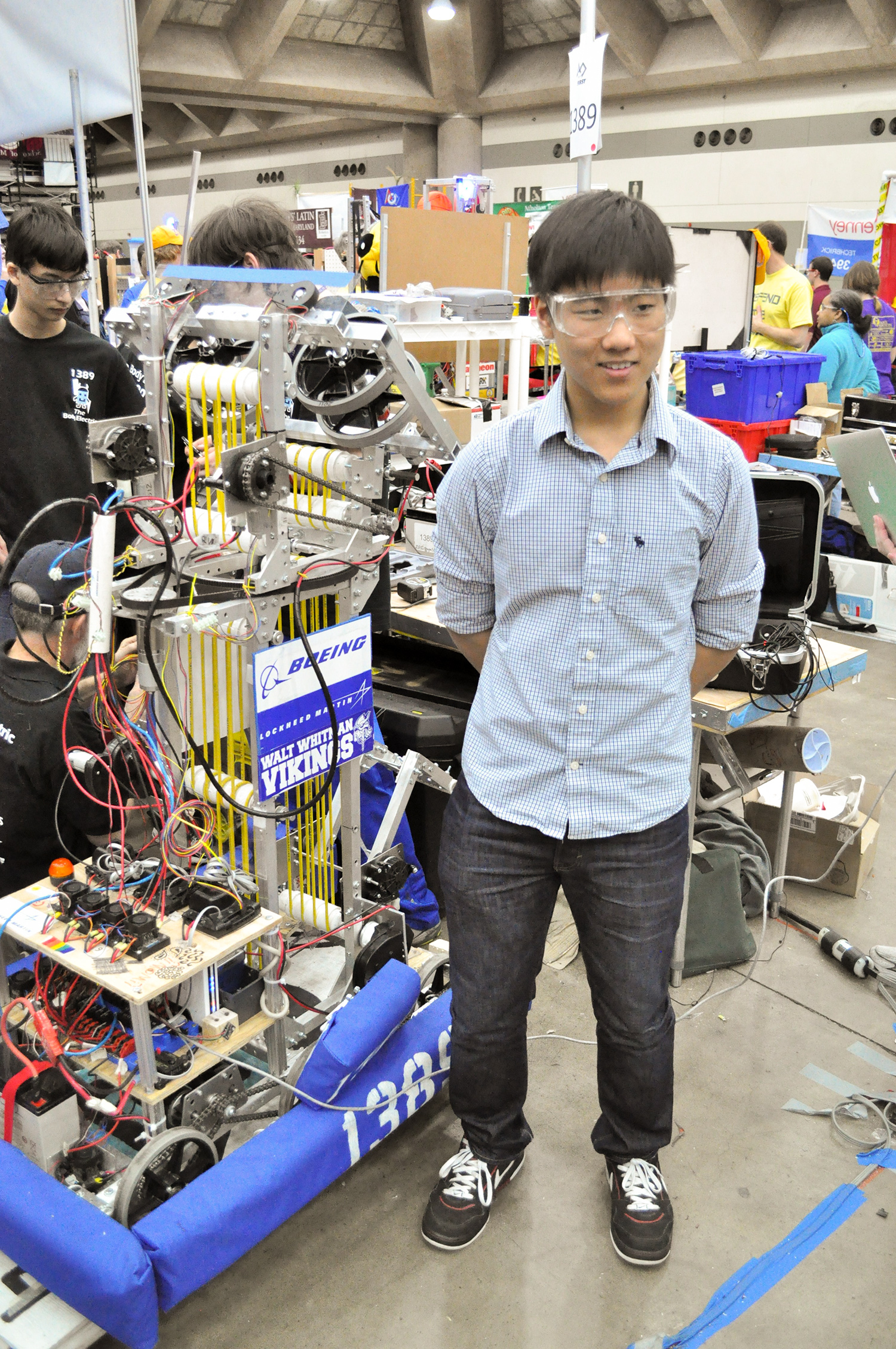
In 2012, while still in high school, Kevin Tyan and his For Inspiration and Recognition of Science and Technology (FIRST) robotics team designed a robot that played basketball—capturing balls and shooting them into hoops—to compete against robots from other schools during the regional FIRST robotics competition.
Marie Ladino: Katherine, just to follow up on that a little bit, what do you think can be done to get more young people, and especially girls, interested in STEM fields?
Katherine Jin: I think the earlier the exposure of STEM to children the better, and the earlier the exposure is also tailored to the child. I think growing up, especially when I did a lot of STEM things as a kid, I remember in elementary school, we had to build a car. And to be quite honest, I didn't really care about that car. So being able to realize that the decisions that we make as teachers inherently can exclude or include people. There are a lot of different ways to show science to children and have them engage with it, but remembering that if we can keep it less gendered, and keep it actually truly accessible for everyone. I also think it's important for teachers and people who are in these positions of influence to also remember that they should constantly be questioning the assumptions that they're making, and to be constantly making sure that what they're doing isn't tailored for one person who may have more access, but is something that all kids can interact with. So getting a scavenger hunt list of things that you need to look for and being sent out in your backyard to find the exact leaves or the exact kind of ferns you're studying about in class. That can really turn something from “this is a really boring book that doesn't apply to me” to “science and math are all around me, and the more I understand, the better I can engage with the world.”
So I do think there's a lot we can do to better improve STEM education for kids.
Marie Ladino: Kevin, what about you? How did you first become interested in science and technology? And did you have particular mentors who helped you?
Kevin Tyan: Yeah, I would say that I have a lot of mentors and professors to thank for shaping me into both the scientist and the innovator that I am today. I never thought that innovating or inventing something was really part of my forte. I always saw myself as the scientist. So I started doing cancer biology research in high school. And for that, I have some of my teachers, like Ms. Melanie Hudock, and then my mentors at NIH [National Institutes of Health], like Dr. [Jane Trepel and] Sunmin Lee, to thank for mentoring me. And so they really hammered home the importance of science and really honing my interest in biology. And then coming to college, we all were led by Dr. Aaron Kyle, who was able to manage us when we won the really unexpected, massive grant from USAID to develop Highlight. When we didn't know what we were doing, he drilled home the point to just stick to the fundamentals, trust the scientific process, plan your experiments rigorously, document your progress. And so those things really resonated for me and developed me into contributing what I can do best for Kinnos, which is really helping to drive the science, digging into patents like you would dig into prior research or reading previous works—that's something that I love to do—writing peer-reviewed articles to prove and validate Kinnos's technology, especially in a science- and health-heavy field where a lot of stakeholders are looking to see that you have peer-reviewed, validated data.
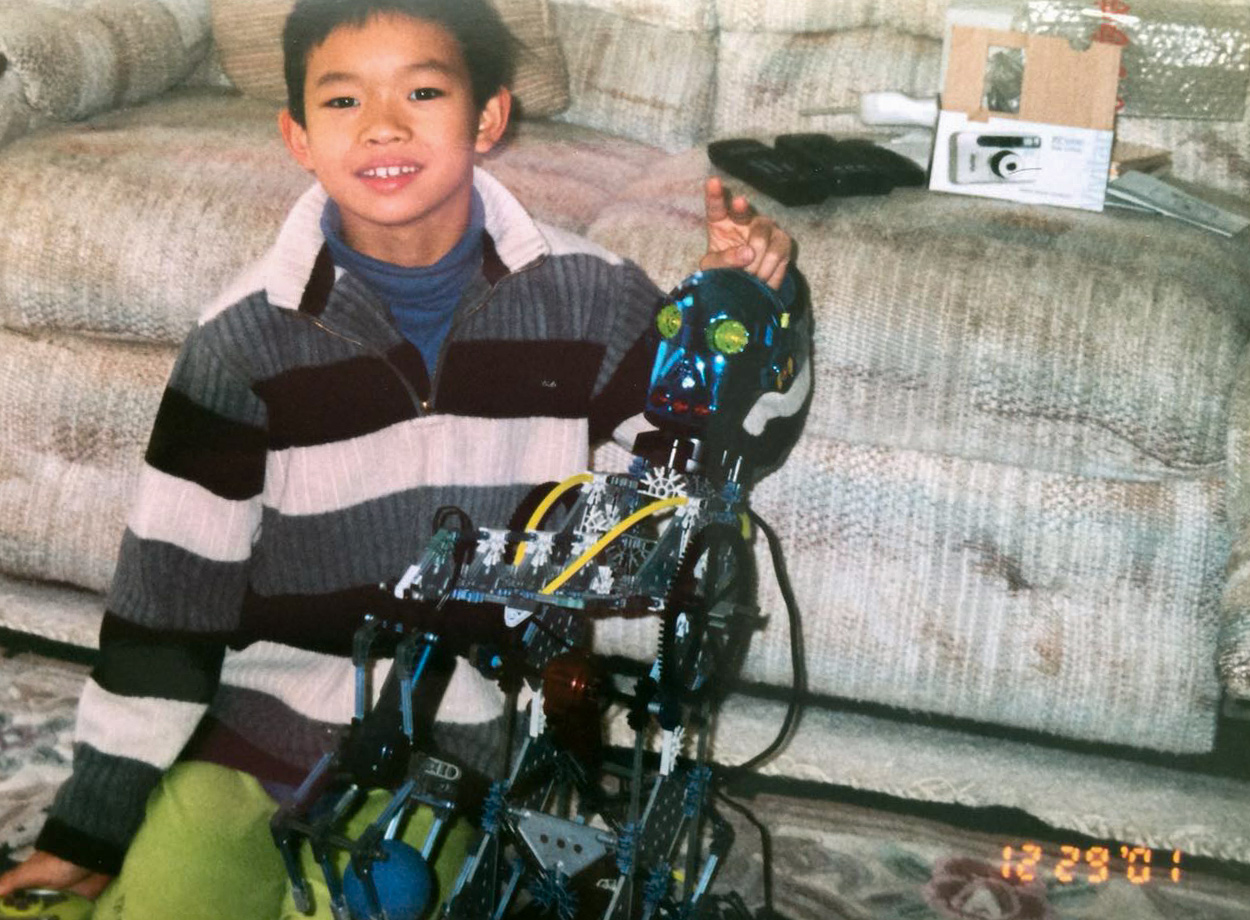
Jason Kang had an early interest in science and engineering. In December 2001, at age 8, Kang proudly posed for this photo with one of his robots.
Marie Ladino: And Jason, what got you started with science and technology?
Jason Kang: I also come from a very lucky and privileged background to say that my dad is a professor at Harvard Medical School. So growing up, I would go to his lab, and I probably wasn't supposed to be allowed to be in there, but I was an 8-year-old, just walking around, looking at all these beakers and stuff. And I thought it was really cool. Then when I got to high school, I started interning in his lab and completely recognizing that this is an opportunity that most people don't have.
Sort of like Kevin, I was going to go down more the route of pure science research. I thought I'd go to college, get my Ph.D., and go into academia like my father. But during college, I had the opportunity to intern at a medical device startup called Jibon Health, and starting to do some more hands-on engineering work. For me, that was the moment where I was like, “Wow, I actually really like being able to make something with my hands and then see how it affects people.” And that kind of veered me toward more of “Maybe I should look into this whole invention technology engineering stuff.” And you know, Kinnos came soon after that, and the rest is history.
Marie Ladino: Since founding Kinnos in 2014, the trio has received four patents and two registered trademarks. They shared with me how critical intellectual property protection has been to their success and some of the challenges they faced as they sought to obtain it.
Jason Kang: When we were first starting, I think it was really important to us that we do capture the intellectual property that we were building. I think for us, we view patents as a way to justify the investment of time and resources and energy into creating these new innovations, not necessarily just because it's important for the business to be able to be the one that commercializes it, but also because if we don't, someone else might, and then that prevents us from really working on it and building it out in the future.
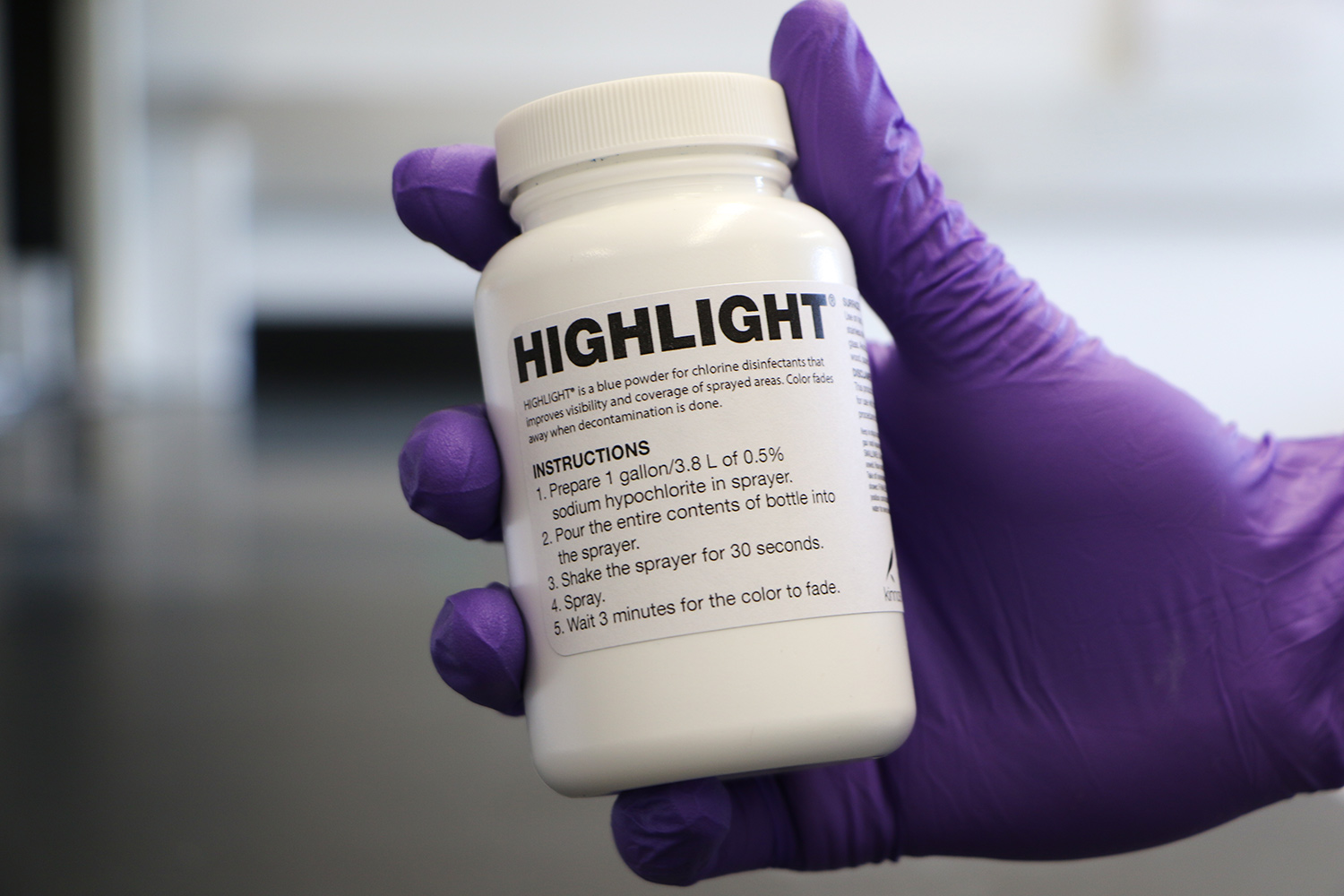
In 2014, the Kinnos team created their first Highlight product, a powdered additive that healthcare and environmental services workers can combine with existing bleach disinfectants.
Kevin Tyan: One of our self-perceived weaknesses was being so small, but it turns out to be a strength, especially when paired with the intellectual property and patent system at the USPTO, because a lot of these massive companies who might like to work on a technology like Highlight don't necessarily have the agility and the flexibility and the speed that a small group of innovators like us do. And so for us to be able to then use the patenting system to then protect our ideas, I think really opened a lot of doors. It was really daunting when we first started, but it turns out there's a lot of good resources for people working on patents for humanitarian causes—of course the Patents for Humanity Award that we won, but also a lot of law firms that provide pro bono services to those who are creating a technology for social enterprises.
Marie Ladino: What was involved in taking Highlight from prototype to patent?
Katherine Jin: Starting off with a cool prototype is only the beginning of it. I think we realized that patent work and patent strategy is on a whole level of complexity that is new to scientists. Even though we had experience writing papers and working in labs before, patenting a technology was totally different. When we first started out as a young team, and we were trying to save money and grind, one of the key areas we wanted to save money in was on our patents.
What we've learned from this process is that if you want to protect your technology and prioritize receiving the patent on your technology, you're going to have to also prioritize spending more money and resources on putting together strong patents. So I definitely want to emphasize the importance of having an expert who can lead you through the process and help you think through your patent strategy. Otherwise, you're just looking at your one product kind of in a vacuum, and you don't have an idea of okay, how is this patent going to build up to more patents?
But in the beginning, how did we take it from prototype to patent? We did a million experiments, kept hundreds and hundreds of pages of data sheets and looked for connections, trying to figure out what we could patent and what we couldn't, compared it to patents that we had already read, figured out what distinguished it, and then put together all of our data and tried to package it together and show that this was a completely new innovation.
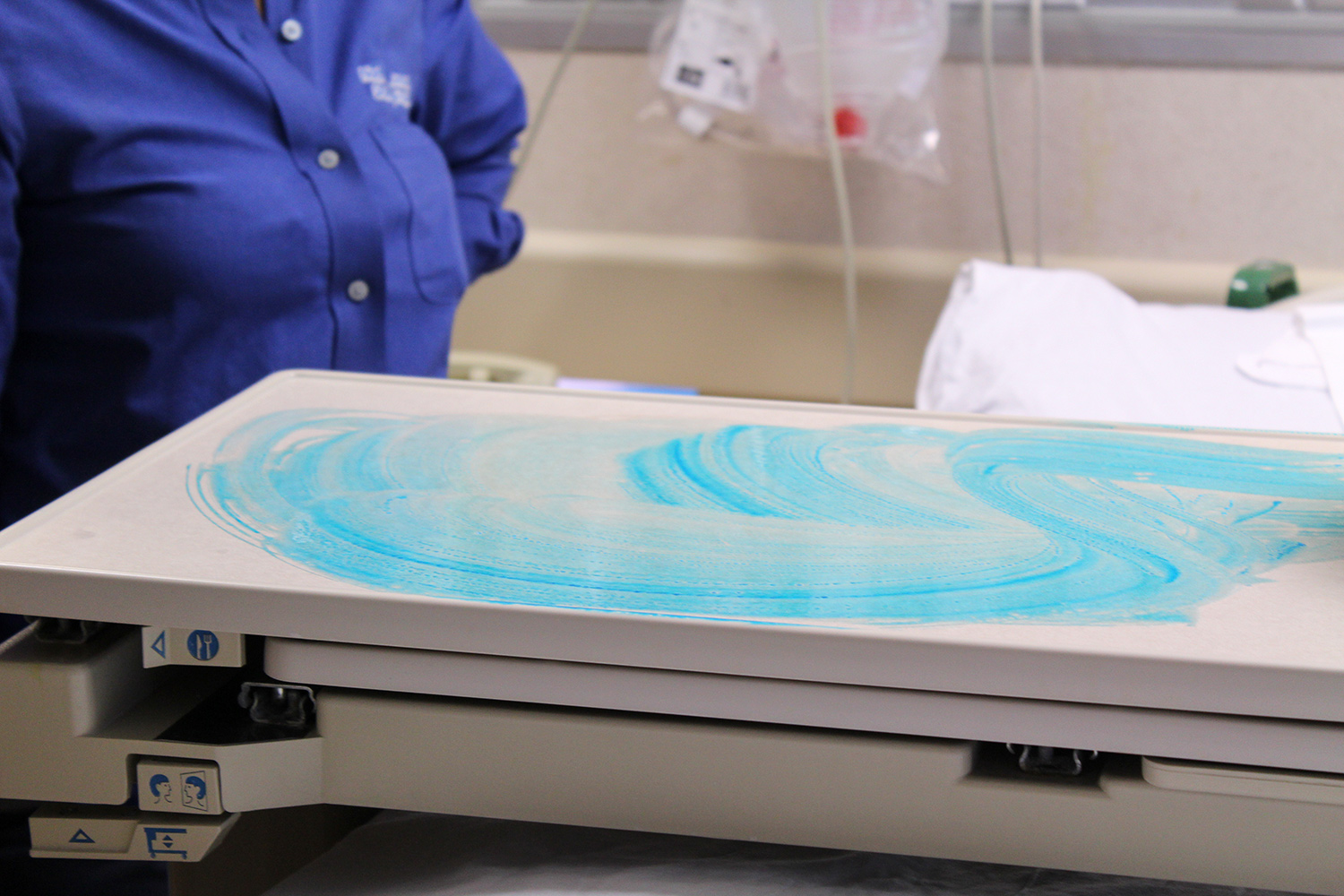
In 2018, Kinnos invented Highlight for Bleach Wipes, a two-part system including a lid that fits on containers of bleach wipes and a cartridge pre-filled with Highlight fluid. The lid dispenses wipes covered with Highlight's signature blue coloring.
Jason Kang: It was a lot of hands-on testing, experimentation, a lot of reading through literature, peer-reviewed publications, patent applications, and patents, and just seeing what the body of work has been. And a lot of iteration, honestly. I think we sort of made the amateur first-time founder mistake of doing a lot of the R&D in the lab at first, and then bringing it out to the field, getting feedback.
Marie Ladino: Did you all experience failures along the way?
Katherine Jin: The longer we did this, the more failures we experienced and also the higher the stakes of the failures. What we've learned really generally is just to expect things to go wrong, to hope for the best, but prepare for the worst, always have a plan B and have a plan C. The major priority is to learn from every failure, to take it not necessarily as a judgment on you personally, but understand what went wrong and how you can do it better and make sure in the future that that failure never repeats.
Jason Kang: I think one of the important things that Katherine mentioned here is really about valuing the failures rather than taking it personally and judging yourself too harshly. Every entrepreneur inventor's journey is filled with a lot of challenges and hurdles.
Kevin Tyan: Right after we attained the USAID funding, we spent the entire winter in a dark dungeon lab developing the first iterations of Highlight. And we got so excited. It was working so well. Every suit that we sprayed, it faded perfectly. The minute summer comes around, we go outside and spray it on a suit. It evaporates instantly. The color is gone.
Things will never work the way you invented it to be, or the way you expect it to be. And that's why it was so important for us to also go to West Africa, to Liberia and Guinea, to work directly with the workers, because in order to know whether this invention works well, you have to see it in the hands of your end users and stakeholders.
This is, I think, still in the middle of the Ebola outbreak in 2015. We were in Liberia, and super excited. We had spent months and months working on this formula of Highlight, hop off the plane and go to the unit, create a batch of bleach, and spray. And then the Highlight just doesn't fade away. It stained their walls. And so we're starting to panic because we think, “Our formula doesn't work. We stained their walls forever. This is terrible.” But along the way, we realized that the problem wasn't with the formula that we made, but with the bleach that the Highlight workers had created. They were told to measure seven spoons of bleach into a liter of water, but they were given the wrong measuring spoon. They were given only a spoon that was half the size. So during the entire outbreak, we discovered that they were creating bleach that was less than half the required concentration, basically spraying themselves with water, no better than water.
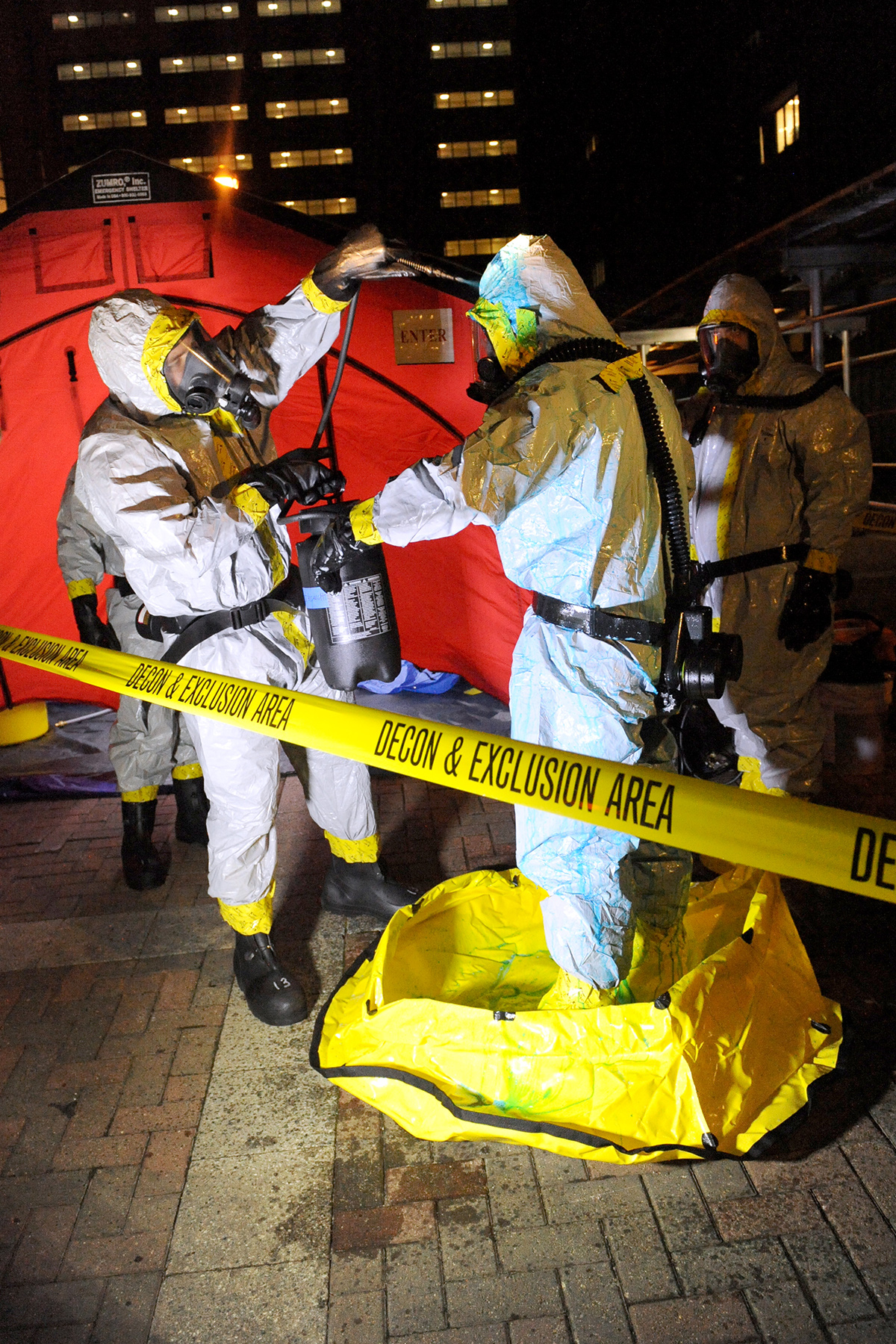
Highlight captured the attention of the Fire Department of New York (FDNY) soon after Kang, Jin, and Tyan invented it, and the FDNY has since purchased the product to equip their firetrucks. In the image above, the FDNY performs a disinfection demonstration using Highlight at Mt. Sinai Hospital.
Marie Ladino: Given all of your experiences so far, what advice would you offer to other innovators and entrepreneurs?
Katherine Jin: It's really important to build a team that is on the same page as you, so that you can feel like you can work together in harmony and that people don't have different priorities. I would definitely say one of the biggest killers of student innovation or early companies is just team drama and team dynamics.
Jason Kang: If I could only give one piece of advice, it would just be to be open-minded. And I think that means a lot of different things, like being open-minded about your ability to do more than you think you can, but also being open-minded to the fact that you also don't know much at all, and being very humble and being willing to learn from others and ask for help. I think being open-minded about who you can be as a person. The amount of personal growth you can experience while running a company is immense if you are open-minded—I think the type of leader you're able to be, the type of listener you can be, the type of team that you can build. When we first started, for example, I definitely was not the best listener or the best delegator or the best communicator, and it took a while for me to realize that I don't have to act a certain way, I don't have to do things a certain way. There's better ways to do things. So I think if you're open-minded and willing to reflect, you can change a lot. And I think that change is really important if you truly want to make an impact.
Marie Ladino: Jason Kang, Katherine Jin, and Kevin Tyan have already made a big impact through their ability and desire to help others. As they continue on their path as inventors and entrepreneurs, they, like many of the innovators we’ve learned about in our Journeys of Innovation series, will tackle other hard problems by working together, and remaining humble and open-minded along the way.
From the USPTO, thanks for listening.
Credits
Produced by the USPTO Office of the Chief Communications Officer. For feedback or questions, please contact inventorstories@uspto.gov.
Interview and story production by Marie Ladino. Audio editing by and contributions from Jay Premack. Additional contributions from Lauren Emanuel. Unless otherwise noted, all images are courtesy of Kinnos.
The transcript has been edited for brevity.


